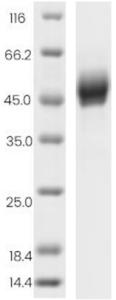Cynomolgus VSTM3 Protein, His Tag
-
产品编号
KMP2422
-
别名
具有免疫球蛋白和 ITIM 结构域的 T 细胞免疫受体, T-cell immunoreceptor with Ig and ITIM domains,, VSIG9
-
规格
- 50ug
- 100ug
- 200ug
| Catalog Number | KMP2422 |
| Alias | 具有免疫球蛋白和 ITIM 结构域的 T 细胞免疫受体, T-cell immunoreceptor with Ig and ITIM domains,, VSIG9 |
| Size | 50ug, 100ug, 200ug |
| Product Description | The Cynomolgus VSTM3 Protein(KMP2422) is produced in HEK293 Cells and the target gene encoding Met89-Pro209 is expressed with a 6His tag at the C-terminus. |
| Molecular Name | VSTM3 |
| Product Introduction | VSTM3:V-set域跨膜蛋白,参与免疫细胞的信号转导和功能调节。 |
| Molecular Weight | 13.97 kDa |
| Expression System | HEK293 Cells |
| Species | Cynomolgus |
| Purity | >95% |
| SDS-PAGE |  |
| Purification | Affinity Purification |
| Uniprot ID | G7NXM4 |
| Storage Condition | Aliquot and store at -20℃ to -80℃. Avoid repeated freezing and thawing cycles. |
| Formulation | PBS, pH7.4 |
| Shipping Condition | In general, the proteins are provided as lyophilized powder which are shipped at ambient temperature. They are shipped out in dry ice if supplied in liquid form. |
| Background | T cell immunoreceptor with Ig and ITIM domains(TIGIT), also called VSIG9 and Vstm3, is a member of the CD28 family within the Ig superfamily of proteins. TIGIT contains an immunoglobulin variable domain, a transmembrane domain and an immunoreceptor tyrosine-based inhibitory motif(ITIM), and is expressed on regulatory, memory, activated T cells and NK cells. TIGIT binds to CD155(PVR) that appear on dendritic cells(DC), macrophages and endothelium with high affinity, and CD112(PVRL2) with lower affinity, but not CD113(PVRL3). TIGIT-Fc fusion protein could interact with PVR on DC and enhance the secretion of IL-10, but inhibit the macrophage activation. Mice lacking TIGIT show increased T cell responses and susceptibility to autoimmune challenges, while knockdown of TIGIT with siRNA in human memory T cells did not affect T cell responses. |
| Endotoxin | <1.0 EU/ug determined by the LAL method |
| Product Declaration | 该产品仅供科研使用,不可直接用于人体或注射。 |
可优化表达条件(如降低诱导温度、调整IPTG浓度)、使用促溶标签(如SUMO、GST)、共表达分子伴侣,或尝试不同宿主系统(如哺乳动物细胞或昆虫细胞)以提高可溶性蛋白产量。
常用的纯化方法包括亲和层析(如His-Tag、GST-Tag)、离子交换层析、疏水相互作用层析(HIC)和凝胶过滤层析。具体方法取决于蛋白特性和标签类型。





 0
0
